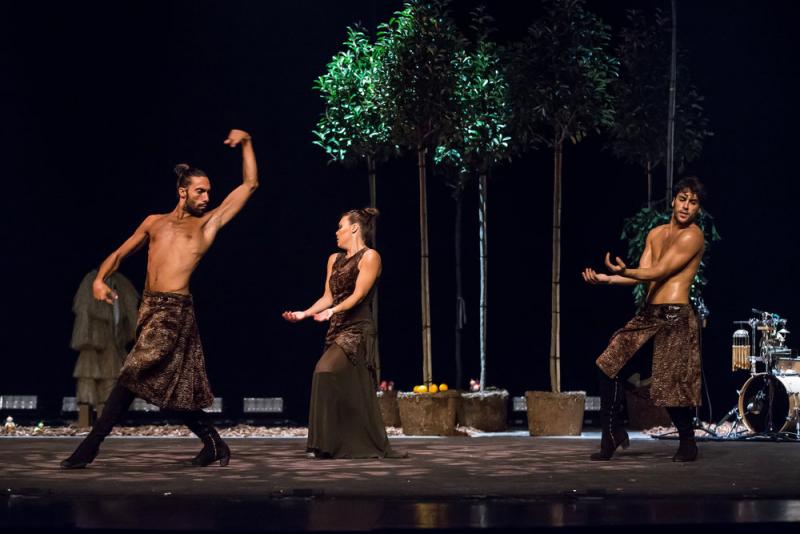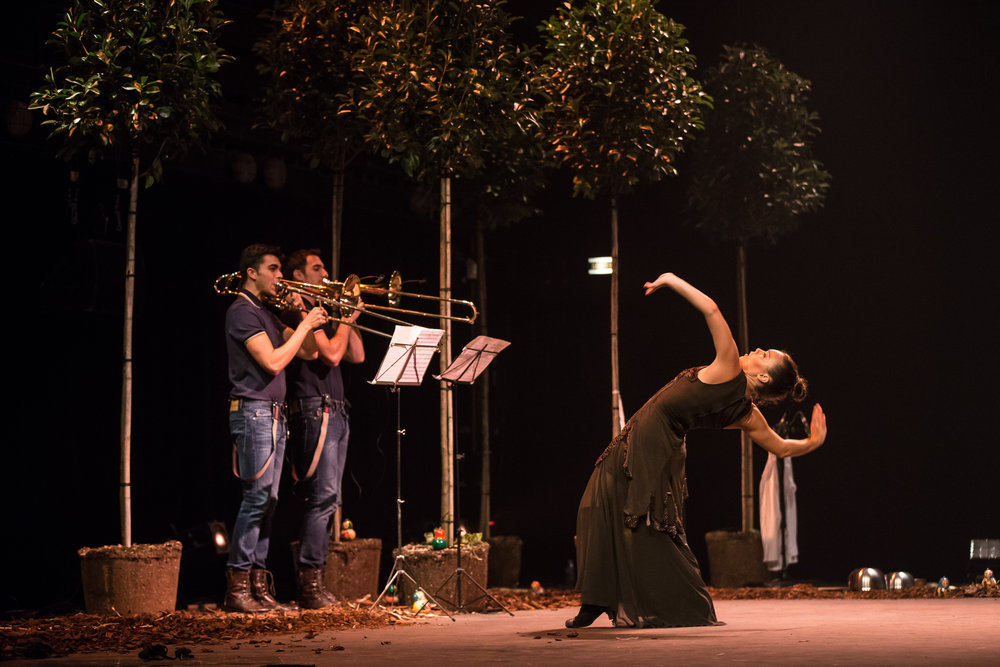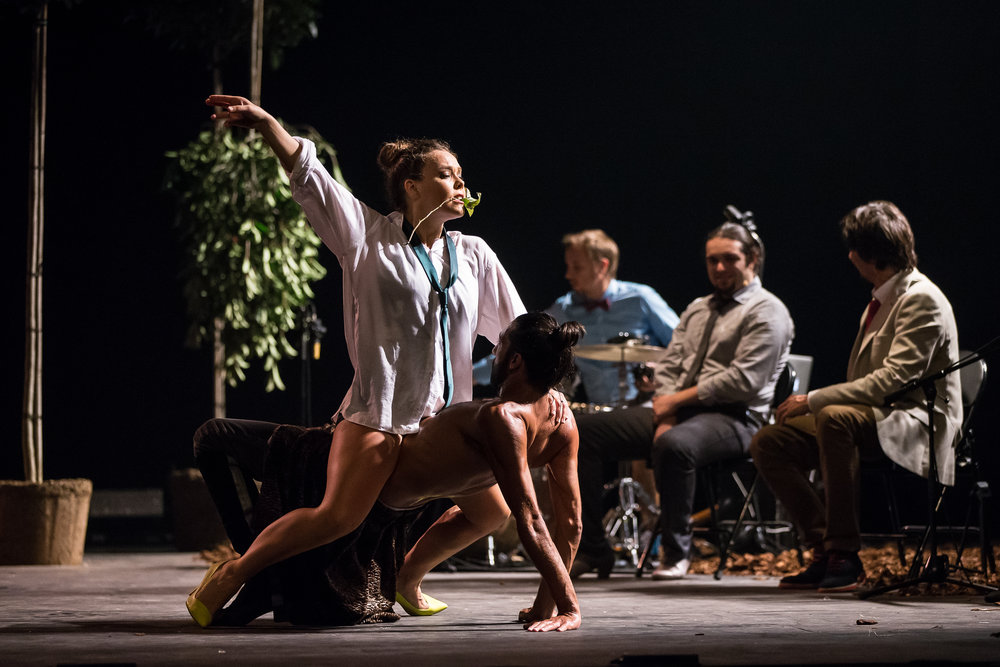Bosque Ardora, Rocío Molina, Barbican | reviews, news & interviews
Bosque Ardora, Rocío Molina, Barbican
Bosque Ardora, Rocío Molina, Barbican
Flamenco innovator presents a woodland realm to remember

Thirty-year-old Rocío Molina has been rattling cages in the hide-bound world of flamenco. Back home in Spain, gloom-mongers are predicting she’ll bring down the art form with her brazen, off-the-leash excursions from its honoured tropes. Her shows are popular.
Not one of the scenic or sartorial elements we’ve learnt to expect in theatre-mounted flamenco remains. No blood-red moon, no processional, no old men banging staves, no shawls, frills or mantillas. Molina even ditches the usual closing bulerias guaranteed to send audiences out on a partying high.
Instead, with the help of a dramaturg and video and audio artists, she has created on stage a rustling, shadowy forest (her “Bosque Ardora”), in which to play out dreams and dark yearnings, drawing on Greek myth. A film sequence sets the bosky scene, a soundscape of pops and slurps suggesting the busy fecundity of nature. Molina on horseback – as the huntress Artemis -.crashes through the trees and into a lake. Yet what emerges, sodden, is her prey, the one that always gets away: the legendary Teumessian Fox.
 For the next half-hour or more, Molina will switch back and forth between the Artemis persona (strong, fearless, indomitable) and the foxy one (sly, clever, secretive). But though it takes a while before you twig the rules of this shapeshifting game, there is much to enjoy in the live music. Clearly, Rocio Molina is not throwing out the baby with the bathwater. The cante jondo in this show, from a radiant-voiced Jose Angel Carmona, and the guitar-playing of Eduardo Trassierra, is deeply traditional, and magnificent.
For the next half-hour or more, Molina will switch back and forth between the Artemis persona (strong, fearless, indomitable) and the foxy one (sly, clever, secretive). But though it takes a while before you twig the rules of this shapeshifting game, there is much to enjoy in the live music. Clearly, Rocio Molina is not throwing out the baby with the bathwater. The cante jondo in this show, from a radiant-voiced Jose Angel Carmona, and the guitar-playing of Eduardo Trassierra, is deeply traditional, and magnificent.
But what’s this? A pair of trombonists (pictured above right)! At first I mistake them in the gloom for dancers with big shiny props. But when they launch into a fast, contrapuntal duet worthy of Hindemith, from memory, while striding about the ‘forest’, you open your ears. This is serious, virtuoso stuff, skilfully embedded in the drama. Joined by electric bass guitar, it’s wackier and more wonderful still.
Back to the inner animal: Molina initially wears a fox mask, but it’s soon discarded. She relies on subtler ways of embodying her inner vixen: her arms and hands, moulded by the tendril-furlings of flamenco, repeatedly come to rest as paws. Spins and stamps remain her default moves, but she peppers them with rhythmic twitchings, whole-body shake-outs, conversational gestures repeated on a loop, and a wilful inversion of the usual flamenco foot which involves her rocking back on her heels, digging at the floor.
 The male dancers in her team are a technical match for her. Dressed in casual clothes (one of them, in shorts, looks as if he’s been out jogging), or stripped to the waist, Eduardo Guerrero and Fernando Jimenez share much of her dance material making a tight and often thrilling unison. In her Artemis persona (dressed in nothing but teetering stilettos and a boyfriend shirt), Molina constantly gets the better of the guys, stepping over their bodies, or slapping out rhythms on a bare manly chest, just for the hell of it. There is comedy, too, as she and whichever male she happens to favour act out the awkward mating rituals of insects, or of birds, passing twigs from beak to beak. But the tone is always sharp, never romantic.
The male dancers in her team are a technical match for her. Dressed in casual clothes (one of them, in shorts, looks as if he’s been out jogging), or stripped to the waist, Eduardo Guerrero and Fernando Jimenez share much of her dance material making a tight and often thrilling unison. In her Artemis persona (dressed in nothing but teetering stilettos and a boyfriend shirt), Molina constantly gets the better of the guys, stepping over their bodies, or slapping out rhythms on a bare manly chest, just for the hell of it. There is comedy, too, as she and whichever male she happens to favour act out the awkward mating rituals of insects, or of birds, passing twigs from beak to beak. But the tone is always sharp, never romantic.
A more confusing scene shows the man as the dominating force, Molina affecting a limp, almost drunken state, losing her shoes and ending up being carried off slung across the bloke’s shoulders, like a dead deer. A second viewing might have made sense of this. But perhaps Molina is trying to tell it like it is: modern single womanhood, club culture, and all that.
Mould-breaking as it is, the spectacle reverts to type in spilling its emotional guts in its penultimate number. Quixotic, complex, even chaotic, Rocio Molina roused is like a river in spate. At one point she is apparently fighting back tears – of what? … anger, frustration, the painful, never-ending compulsion to keep up with her runaway-train feet? On this evidence, she is already a challenger for the crown, matching the soulful intensity of Eva Yerbabuena, the streamlined attack of Sara Baras. And she adds an unpredictability that is distinctly her own.
- Bosque Ardora is at the Barbican Theatre until 18 October. The Dance Umbrella Festival runs till 31 October.
more Dance
 All You Need Is Death review - a future folk horror classic
Irish folkies seek a cursed ancient song in Paul Duane's impressive fiction debut
All You Need Is Death review - a future folk horror classic
Irish folkies seek a cursed ancient song in Paul Duane's impressive fiction debut
 MacMillan Celebrated, Royal Ballet review - out of mothballs, three vintage works to marvel at
Less-known pieces spanning the career of a great choreographer underline his greatness
MacMillan Celebrated, Royal Ballet review - out of mothballs, three vintage works to marvel at
Less-known pieces spanning the career of a great choreographer underline his greatness
 Carmen, English National Ballet review - lots of energy, even violence, but nothing new to say
Johan Inger's take on Carmen tries but fails to make a point about male violence
Carmen, English National Ballet review - lots of energy, even violence, but nothing new to say
Johan Inger's take on Carmen tries but fails to make a point about male violence
 WAKE, National Stadium, Dublin review - a rainbow river of dance, song, and so much else
THISISPOPBABY serves up a joyous tapestry of Ireland contemporary and traditional
WAKE, National Stadium, Dublin review - a rainbow river of dance, song, and so much else
THISISPOPBABY serves up a joyous tapestry of Ireland contemporary and traditional
 Swan Lake, Royal Ballet review - grand, eloquent, superb
Liam Scarlett's fine refashioning returns for a third season, and looks better than ever
Swan Lake, Royal Ballet review - grand, eloquent, superb
Liam Scarlett's fine refashioning returns for a third season, and looks better than ever
 First Person: Ten Years On - Flamenco guitarist Paco Peña pays tribute to his friend, the late, great Paco de Lucía
On the 10th anniversary of his death, memories of the prodigious musician who broadened the reach of flamenco into jazz and beyond
First Person: Ten Years On - Flamenco guitarist Paco Peña pays tribute to his friend, the late, great Paco de Lucía
On the 10th anniversary of his death, memories of the prodigious musician who broadened the reach of flamenco into jazz and beyond
 Dance for Ukraine Gala, London Palladium review - a second rich helping of international dancers
Ivan Putrov's latest gala was a satisfying mix of stars and young hopefuls
Dance for Ukraine Gala, London Palladium review - a second rich helping of international dancers
Ivan Putrov's latest gala was a satisfying mix of stars and young hopefuls
 Nelken: A Piece by Pina Bausch, Sadler's Wells review - welcome return for an indelible classic
A new generation of gifted performers for us to get to know
Nelken: A Piece by Pina Bausch, Sadler's Wells review - welcome return for an indelible classic
A new generation of gifted performers for us to get to know
 Dark With Excessive Bright, Royal Ballet review - a close encounter with dancers stripped bare
The Royal's Festival of New Choreography launches with an unforgettable walk in the dark
Dark With Excessive Bright, Royal Ballet review - a close encounter with dancers stripped bare
The Royal's Festival of New Choreography launches with an unforgettable walk in the dark
 La Strada, Sadler's Wells review - a long and bumpy road
Even the exceptional talents of Alina Cojocaru can't save dance adaptation of Fellini film
La Strada, Sadler's Wells review - a long and bumpy road
Even the exceptional talents of Alina Cojocaru can't save dance adaptation of Fellini film
 First Person: pioneering juggler Sean Gandini reflects on how the spirit of Pina Bausch has infiltrated his work
As Tanztheater Wuppertal Pina Bausch's 'Nelken' comes to Sadler’s Wells, a tribute from across the art forms
First Person: pioneering juggler Sean Gandini reflects on how the spirit of Pina Bausch has infiltrated his work
As Tanztheater Wuppertal Pina Bausch's 'Nelken' comes to Sadler’s Wells, a tribute from across the art forms
 Manon, Royal Ballet review - a glorious half-century revival of a modern classic
Fifty years on, Kenneth MacMillan's crash-and-burn anti-heroine is riding high
Manon, Royal Ballet review - a glorious half-century revival of a modern classic
Fifty years on, Kenneth MacMillan's crash-and-burn anti-heroine is riding high

Add comment